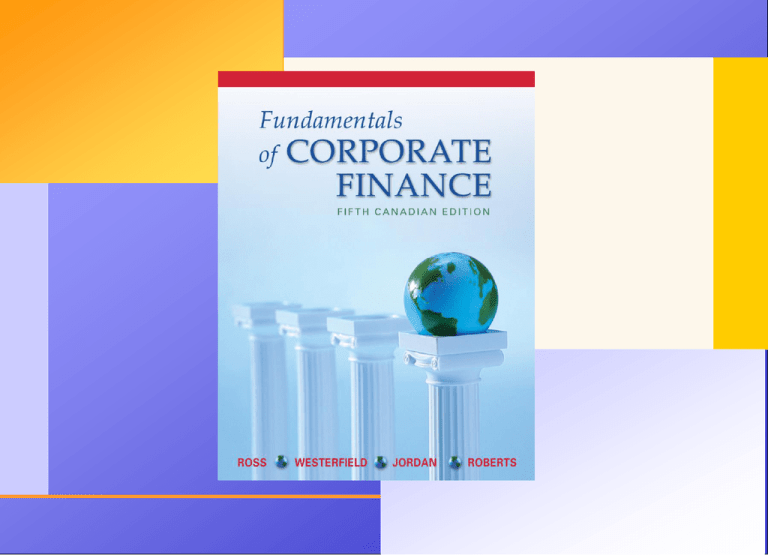
© 2005
McGraw-Hill
Limited
© 2003 The McGraw-Hill
Companies,
Inc. AllRyerson
rights reserved.
Chapter
One
Introduction To
Corporate Finance
© 2003 The McGraw-Hill Companies, Inc. All rights reserved.
1.1
Key Concepts and Skills
• Know the basic types of financial management
decisions and the role of the financial manager
• Know the financial implications of the different forms
of business organization
• Know the goal of financial management
• Understand the conflicts of interest that can arise
between owners and managers
• Understand the various types of financial markets and
financial institutions
• Understand current trends in Canadian financial markets
© 2005 McGraw-Hill Ryerson Limited
1.2
Chapter Outline
•
•
•
•
•
•
•
Corporate Finance and the Financial Manager
Forms of Business Organization
The Goal of Financial Management
The Agency Problem and Control of the
Corporation
Financial Markets and the Corporation
Financial Institutions
Trends in Financial Markets and Financial
Management
© 2005 McGraw-Hill Ryerson Limited
1.3
Corporate Finance
• Some important questions that are answered
using finance
– What long-term investments should the firm take
on (capital budgeting)?
Open a new store, acquire new equipment, etc.
– Where will we get the long-term financing to pay
for the investment (capital structure – debt vs.
equity)?
– How will we manage the everyday financial
activities of the firm
(working capital management – inventory, money
owed to suppliers, accounts receivable)?
© 2005 McGraw-Hill Ryerson Limited
1.4
Financial Manager
• Financial managers try to answer some or all of
these questions
• The top financial manager within a firm is
usually the Chief Financial Officer (CFO)
– Treasurer – oversees cash management, capital
expenditures and financial planning
– Controller – oversees taxes, cost accounting,
financial accounting and data processing (MIS)
– Show Fig. 1.1 @ page 4!
© 2005 McGraw-Hill Ryerson Limited
1.5
Financial Management Decisions
• Capital budgeting
– What long-term investments or projects should the
business take on?
• Capital structure
– How should we pay for our assets?
– Should we use debt or equity?
• Working capital management
– How do we manage the day-to-day finances of the
firm?
© 2005 McGraw-Hill Ryerson Limited
1.6
Forms of Business Organization
• Three major forms in Canada
– Sole proprietorship – owned by one person
– Partnership – owned by many partners
• General – all partners unlimited liability
• Limited – some partners do not actively participate and
have limited liability
– Corporation – legal entity separate from its owners
• In other countries, corporations are also called joint stock
companies, public limited companies and limited liability
companies
© 2005 McGraw-Hill Ryerson Limited
1.7
Sole Proprietorship
• Advantages
– Easiest to start
– Least regulated
– Single owner keeps all
the profits
– Taxed once as personal
income
• Disadvantages
– Unlimited liability
– Limited to life of owner
– Equity capital limited to
owner’s personal wealth
– Difficult to sell (transfer)
ownership interest
© 2005 McGraw-Hill Ryerson Limited
1.8
Partnership
• Advantages
–
–
–
–
Two or more owners
More capital available
Relatively easy to start
Income taxed once as
personal income
• Disadvantages
– Unlimited liability
• General partnership
• Limited partnership
– Partnership dissolves
when one partner dies or
wishes to sell
– Difficult to transfer
ownership
© 2005 McGraw-Hill Ryerson Limited
1.9
Corporation
• Advantages
– Limited liability
– Unlimited life
– Separation of ownership
and management
– Transfer of ownership is
easy
– Easier to raise capital
• Disadvantages
– Separation of ownership
and management
– Double taxation (income
– corporate profits - is
taxed at the corporate rate
and then dividends are
taxed at the personal rate)
© 2005 McGraw-Hill Ryerson Limited
1.10
An International Perspective
© 2005 McGraw-Hill Ryerson Limited
1.11
Goal Of Financial Management
• What should be the goal of a corporation?
–
–
–
–
Maximize profit? Avoid bankruptcy?
Minimize costs? Survive in business?
Maximize market share?
Maximize the current value of the company’s
stock?
• Does this mean we should do anything and
everything to maximize owner wealth?
© 2005 McGraw-Hill Ryerson Limited
1.12
Primary Goal of Financial Management
• Three equivalent goals of financial management:
–
–
–
–
Maximize shareholder wealth
Maximize share price
Maximize firm value
OR: to maximize the current value per share of existing
stock (note: For the stock price to be an accurate measure of
the financial manager’s performance, we need capital
markets to do their pricing job correctly - we need capital
markets to be efficient. In an efficient capital market, all
available information is incorporated into stock prices, and
thus what the financial manager knows, the shareholders
know it, too).
© 2005 McGraw-Hill Ryerson Limited
1.13
The Agency Problem
• Agency relationship
– Principal hires an agent to represent their interests
– Stockholders (principals) hire managers (agents) to
run the company
• Agency problem
– Conflicts of interest can exist between the
principal and the agent
• Agency costs
– Direct agency costs (luxurious jet, auditors)
– Indirect agency costs (lost opportunity)
© 2005 McGraw-Hill Ryerson Limited
1.14
Managing Managers
• Managerial compensation
– Incentives can be used to align management and stockholder
interests (tie perform. to share value, labour market)
– The incentives need to be structured carefully to make sure that
they achieve their goal
• Corporate control
– The threat of a takeover may result in better management
• Conflicts with other stakeholders
– The incentives need to be structured carefully to make sure that
they achieve their goal (a stakeholder is anybody with a claim on
the cash flows of the firm, such as creditors, employees, and
shareholders, of course. Somehow stakeholders may push for
higher costs to the firms, such as employee benefits, social and
environmental considerations. Firms nevertheless need to take
account of these considerations).
© 2005 McGraw-Hill Ryerson Limited
1.15
Work the Web Example
• The Internet provides a wealth of information
about individual companies
• One excellent site is finance.yahoo.com
• Click on the web surfer to go to the site, choose
a company and see what information you can
find!
© 2005 McGraw-Hill Ryerson Limited
1.16
What is the role of financial markets in corporate finance?
• Cash flows to and from the firm (show Fig. 1.3,
page 15)
• Money (short-term debt) vs. capital markets
(long-term debt and shares: TSX)
• Primary (public offerings->underwritten by an
investment dealer) vs. secondary markets
(transferring ownership: auction markets and
dealer markets)
• How do financial markets benefit society?
(transfer, raise?)
© 2005 McGraw-Hill Ryerson Limited
1.17
Cash Flows to and from the Firm
© 2005 McGraw-Hill Ryerson Limited
1.18
Financial Institutions
• Financial institutions act as intermediaries
between suppliers and users of funds
• Institutions earn income on services provided:
– Indirect finance – Earn interest on the spread
between loans and deposits
– Direct finance – Service fees (i.e. bankers
acceptance and stamping fees)
© 2005 McGraw-Hill Ryerson Limited
1.19
Trends in Financial Markets and Management
•
•
•
•
•
Financial Engineering
Derivative Securities
Advances in Technology – i.e. E-business
Deregulation (large institutions)
Corporate Governance Reform (stronger,
independent BoD)
© 2005 McGraw-Hill Ryerson Limited
1.20
Quick Quiz
• What are the three types of financial
management decisions and what questions are
they designed to answer?
• What are the three major forms of business
organization?
• What is the goal of financial management?
• What are agency problems and why do they
exist within a corporation?
• What is the difference between a primary
market and a secondary market?
© 2005 McGraw-Hill Ryerson Limited
1.21
Summary 1.9
• You should know:
– The advantages and disadvantages between a sole
proprietorship, partnership and corporation
– The primary goal of the firm
– What an agency relationship and cost are
– The role of financial markets
© 2005 McGraw-Hill Ryerson Limited




